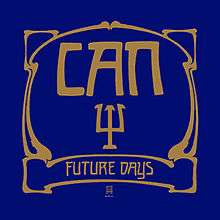Future Days
Future Days is the fourth studio album by the German experimental rock group Can, originally released in 1973. It is the last Can album to feature Japanese vocalist Damo Suzuki.
| Future Days | ||||
|---|---|---|---|---|
 | ||||
| Studio album by | ||||
| Released | August 1973 | |||
| Recorded | 1973 | |||
| Genre | ||||
| Length | 40:56 | |||
| Label | United Artists Records | |||
| Producer | Can | |||
| Can chronology | ||||
| ||||
| Review scores | |
|---|---|
| Source | Rating |
| AllMusic | |
| Encyclopedia of Popular Music | |
| Pitchfork | 8.8/10[4] |
| PopMatters | very favorable[5] |
| The Rolling Stone Album Guide | |
Content
Music
On Future Days, the band foregrounds the ambient elements they had begun exploring on previous efforts, dispensing largely with traditional rock song structures and instead "creating hazy, expansive soundscapes dominated by percolating rhythms and evocative layers of keys."[1] PopMatters wrote that "It feels as if Future Days is driven by a coastal breeze, exuding a more pleasant, relaxed mood than anything the band had previously recorded."[7]
Artwork
The album cover shows a Psi sign in the middle (drawn in the same style as the font used for the cover) and the I Ching symbol ding/the cauldron below the title. The surrounding graphics are based on the Jugendstil artstyle.
Some versions of the vinyl album have a slightly different cover in which the graphics don't have a light emboss or in which the lightly reflective gold tint is replaced by a flat yellow instead. These differences are also present on the CD releases. Even though not all versions of the covers are fully identical, the tracks do not differ on any release version whatsoever.
Legacy
The album was ranked number 8 on Rolling Stone's 50 Greatest Prog Rock Albums of All Time list.[8] Pitchfork named it the 56th greatest album of the 1970s.[9] In 1995 Mojo also named it the 62nd greatest album of all time.[10]
Track listing
All tracks are written by Holger Czukay, Michael Karoli, Jaki Liebezeit, Irmin Schmidt and Damo Suzuki.
| No. | Title | Length |
|---|---|---|
| 1. | "Future Days" | 9:30 |
| 2. | "Spray" | 8:29 |
| 3. | "Moonshake" | 3:04 |
| No. | Title | Length |
|---|---|---|
| 1. | "Bel Air" | 19:53 |
| Total length: | 40:56 | |
Personnel
- Holger Czukay – bass, double bass
- Michael Karoli – guitar, violin
- Jaki Liebezeit – drums, percussion
- Irmin Schmidt – keyboards, synthesizers
- Damo Suzuki – vocals, percussion
References
- Ankeny, Jason. "Can: Future Days > Review" at AllMusic. Retrieved 2 November 2011.
- "50 Greatest Prog Rock Albums of All Time". Rolling Stone.
- Larkin, Colin (2011). "Can". Encyclopedia of Popular Music (5th ed.). Omnibus Press. ISBN 0857125958.
- Leone, Dominique (12 July 2005). "Can: Future Days". Pitchfork Media. Retrieved 2 November 2011.
- Begrand, Adrien (5 August 2005). "For the Sake of Future Days: Can's Second Golden Era". PopMatters. Retrieved 28 January 2017.
- Nathan Brackett; Christian David Hoard (2004). The new Rolling Stone album guide. New York: Simon & Schuster. p. 134. ISBN 978-0-7432-0169-8.
- "For the Sake of Future Days: Can's Second Golden Era". PopMatters. Retrieved 20 July 2017.
- "50 Greatest Prog Rock Albums of All Time". Rolling Stone. 17 June 2015. Retrieved 31 August 2015.
- "Top 100 Albums of the 1970s – Page 5". pitchfork.com. Retrieved 28 January 2017.
- Stephen, Gordon (August 1995). "Rocklist.net...Mojo Lists..." Mojo. Retrieved 28 January 2017.